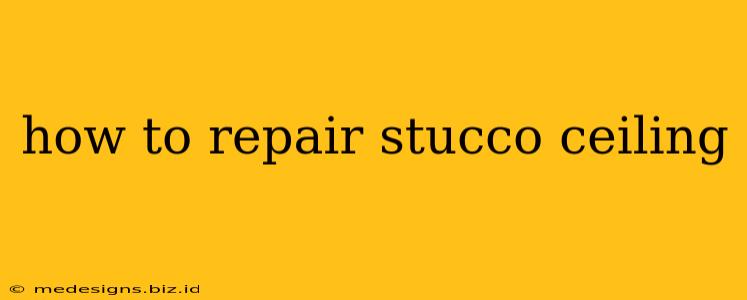A beautiful stucco ceiling adds character and charm to your home. But, like any other part of your house, it's susceptible to damage. Cracks, holes, and discoloration can detract from its aesthetic appeal. Fortunately, many stucco ceiling repairs are manageable DIY projects. This guide will walk you through the process of repairing your stucco ceiling, from identifying the problem to achieving a seamless finish.
Assessing the Damage: Understanding Your Stucco Ceiling Repair Needs
Before you grab your tools, take some time to thoroughly assess the damage to your stucco ceiling. This will help you determine the best repair method and the necessary materials.
Types of Stucco Ceiling Damage:
- Small Cracks: These are often caused by minor settling or expansion and contraction. They are usually less than ⅛ inch wide.
- Larger Cracks: Wider cracks (⅛ inch to ½ inch) can indicate more significant structural issues.
- Holes: Holes can result from impact damage or water damage. The size and depth will determine the repair approach.
- Loose or Crumbling Stucco: This suggests moisture problems or age-related deterioration.
Gathering Your Materials:
The specific materials you'll need depend on the extent of the damage. However, you'll likely need some or all of the following:
- Safety Glasses and Dust Mask: Protecting yourself from dust and debris is paramount.
- Putty Knife or Scraper: For removing loose or damaged stucco.
- Wire Brush: To clean the area before applying repair material.
- Stucco Patching Compound: Choose a compound that matches your existing stucco's color and texture.
- Caulk: For filling smaller cracks.
- Mesh Tape (for larger cracks): Provides reinforcement for larger cracks.
- Primer: To prepare the surface for paint.
- Paint (matching your existing stucco): For a seamless finish.
- Sandpaper: For smoothing out the repaired area.
- Drop Cloths: To protect your floor and furniture.
- Ladder (if necessary): For safe access to the ceiling.
Step-by-Step Stucco Ceiling Repair Guide
Step 1: Preparation is Key
- Safety First: Wear your safety glasses and dust mask. Place drop cloths to protect your flooring and furniture.
- Clean the Area: Use a wire brush to thoroughly clean the damaged area, removing all loose or crumbling stucco.
- Assess the Crack/Hole: Determine the size and depth of the damage.
Step 2: Repairing Small Cracks
- Caulk Application: For small cracks, apply a high-quality exterior-grade caulk. Use a caulking gun and smooth it out with a damp finger or putty knife.
Step 3: Repairing Larger Cracks and Holes
- Mesh Tape Reinforcement (Larger Cracks): Apply mesh tape over larger cracks, embedding it into the patching compound.
- Stucco Patch Application: Apply the stucco patching compound, pressing it firmly into the crack or hole. Overfill slightly, allowing for shrinkage.
- Smoothing: Use a wet putty knife or sponge to smooth the surface.
Step 4: Finishing Touches
- Allow to Dry: Let the patching compound dry completely according to the manufacturer's instructions.
- Sanding: Once dry, gently sand the repaired area to achieve a smooth finish. Use increasingly finer sandpaper grits.
- Priming: Apply a primer to ensure the paint adheres properly.
- Painting: Carefully apply paint that matches your existing stucco, using thin coats to avoid drips.
Step 5: Addressing Moisture Problems
If your stucco damage is due to moisture, you must address the underlying cause before attempting a repair. This might involve repairing leaks, improving ventilation, or addressing drainage issues. Ignoring moisture problems will likely lead to recurring damage.
Preventing Future Stucco Ceiling Damage
- Regular Inspection: Regularly inspect your stucco ceiling for signs of damage. Early detection can prevent small problems from becoming large, expensive repairs.
- Proper Ventilation: Ensure adequate ventilation in your home to prevent moisture buildup.
- Address Leaks Promptly: Repair any leaks in your roof or plumbing as quickly as possible.
- Professional Help: For extensive damage or structural concerns, it's always best to consult a qualified stucco contractor.
By following these steps, you can successfully repair minor damage to your stucco ceiling and maintain its beauty for years to come. Remember, safety and thorough preparation are key to a successful outcome. If you're unsure about any step, it's always advisable to seek the help of a professional.
